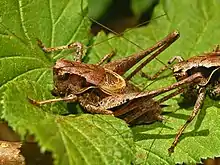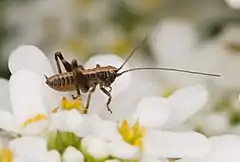Dark bush-cricket
The dark bush-cricket (Pholidoptera griseoaptera) is a flightless species of European bush-cricket; it is the type species of its genus with no subspecies.[1]
| Dark bush-cricket | |
|---|---|
 | |
| Male of Pholidoptera griseoaptera | |
 | |
| Female of Pholidoptera griseoaptera | |
| Scientific classification | |
| Kingdom: | Animalia |
| Phylum: | Arthropoda |
| Class: | Insecta |
| Order: | Orthoptera |
| Suborder: | Ensifera |
| Family: | Tettigoniidae |
| Subfamily: | Tettigoniinae |
| Tribe: | Pholidopterini |
| Genus: | Pholidoptera |
| Species: | P. griseoaptera |
| Binomial name | |
| Pholidoptera griseoaptera (De Geer, 1773) | |
| Synonyms | |
| |
Description

Pholidoptera griseoaptera can reach a body length of 11 to 21 mm (males) and 15 to 20 mm (females), much smaller than the similar Pholidoptera aptera. The sickle-shaped and upward curved ovipositor of the females is 8 to 10 mm long, while the males have two short cerci. The antennae and the hind legs are quite long.
The rounded brachypterous wings of the males are brown with light brown to ochre-coloured edges and are about 5 mm in length (about as long as the pronotum). The females are almost wingless or have half-round, grey-brown fore-wings that are 1-2 mm long. Long-winged (macropterous) forms are not recorded.
Distribution and Biology
This species can be found in Europe from northern Spain up to Crimea, Caucasus and the Near East. It is fairly common in Great Britain, but not recorded from Ireland.[1]
The adults are omnivorous, feeding primarily on small insects such as aphids and caterpillars, but eat also plants such as bramble (Rubus species), dandelion (Taraxacum species) and nettles (Urtica species). The stridulation is a brief and penetrating sound, repeatedly irregularly night and day.
Habitat
The dark bush-cricket colonizes a variety of habitats, but avoids sandy soils and are accordingly rare in sandy areas. It is mainly present in forest edges or clearings, but can be found also in wasteland, parks and gardens, at an elevation of about 0–2,100 metres (0–6,890 ft) above sea level.
The females lay their eggs in the soil, in dead branches, in bark crevices and rotting wood. The eggs need high humidity. The larvae require two years for their full development, with seven larval stages. They feed exclusively on vegetables. Nymphs appear at the end of April of the third year, while the first adults appear in June.
References
External links
- Orthoptera and allied insects
- Paws for Wildlife
 Media related to Pholidoptera griseoaptera at Wikimedia Commons
Media related to Pholidoptera griseoaptera at Wikimedia Commons